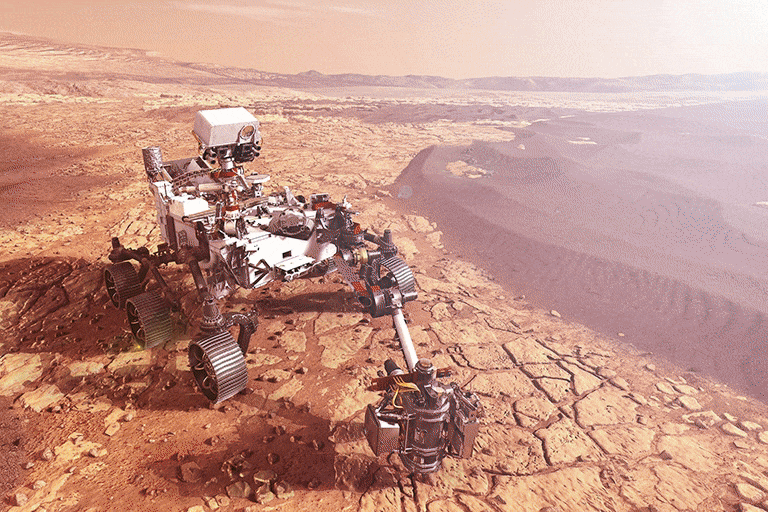Perseverance — Celebrating One Year on Mars
Today marks the one-year anniversary of NASA’s Perseverance rover landing on Mars. After launching in July 2020 and undergoing a 290-million-mile journey, the rover touched down in Mars’ Jezero Crater in February 2021. In the one year that the rover has been on the Red Planet, it has made some exciting discoveries — and it’s only just beginning.
Astrobiology
One of Percy’s (as the rover is fondly known) key objectives on Mars is astrobiology, which includes the search for signs of ancient microbial life. As the first rover to be tasked with collecting and caching samples of Martian rock and regolith, it’s tackling this monumental feat with the help of a robotic arm from Motiv. Stretching over two meters long with five finely tuned joints and a science payload capacity of over 45 kilograms, the robotic arm is equipped to deploy instrumentation specially designed for forensic inspection of past life on Mars.
Percy began its search for ancient Martian life in the Jezero Crater. More than three billion years ago, the crater had been a body of water about the size of Lake Tahoe. And though it has long since dried up, these dry shores are where scientists felt the rover would find signs of potential life. Using a drill on the end of its robotic arm and a complex sample collection system, Perseverance has been collecting rock cores from Jezero’s crater floor. While initial drilling had some issues — including a failed rock core drilling attempt and a snag in the sampling system — Percy has had success. So far, the rover has collected five rock cores, all of which appear to have had interaction with liquid water. This is an exciting find for scientists, as water–rock interactions can have the reactions needed to potentially give rise to life — and power it.
In the coming weeks, Percy will continue to collect samples from across the crater floor. Eventually, the samples will be returned to Earth for in-depth analysis, as part of the Mars Sample Return campaign. By sending the samples back to Earth, scientists hope to gain a better understanding of Jezero’s history and evolution, as well as gain more insight into the mysterious Mars.
Photography
Perseverance is not just in the business of collecting rock cores; sitting just below the instrument shell of the mast of the rover, Motiv’s Mastcam-Z cameras are helping to bring new depth and color to the Mars exploration campaign. With a built-in mechanical zoom feature and advanced stereoscopic, high-definition video, Motiv’s cameras are working to capture imagery that will yield valuable scientific information. Since touching down, the cameras have captured some amazing images from around its Martian landing site, Jezero Crater, and more, giving scientists more insight into the planet’s geology and past climate.
Other Accomplishments
Though it is the heaviest rover (at roughly one ton) to ever touch down on Mars, Percy is not letting its size get in the way of its many missions. In addition to astrobiology, Percy has broken a record for the most distance driven by a Mars rover in a single day, traveling almost 1,050 feet (320 meters) on February 14, 2022. Percy performed this momentous drive using AutoNav, a self-driving software that allows the rover to find its own path around rocks and other obstacles.
Percy is also serving as a base station for Ingenuity, the first robotic helicopter on Mars. The rotorcraft has successfully completed 19 flights now, providing new perspectives of Martian terrain while helping Perseverance’s team plan ahead. Perseverance has also been testing MOXIE (Mars Oxygen In-Situ Resource Utilization Experiment), the first prototype oxygen generator on the Red Planet, which will be crucial whenever astronauts finally make it to Mars.
In just over a year, Perseverance has been hard at work, characterizing Mars’ geology and past climate, collecting and caching rock core samples, and paving the way for human exploration of the Red Planet. Next up for the adventurous rover is making its way to a delta along the west rim of Jezero by late May or early June. Once it arrives at the delta, Perseverance will begin a search for carbon-based molecules. While it is unlikely that Perseverance will see anything that we would recognize as “life,” its findings will be closely examined to see if maybe, just maybe, the beginnings of something were once there.
Sources:
https://nypost.com/2022/02/21/perseverance-mars-rover-marks-a-year-on-red-planet/
https://www.nytimes.com/2022/02/15/science/mars-nasa-perseverance.html
https://www.jpl.nasa.gov/news/nasas-perseverance-celebrates-first-year-on-mars-by-learning-to-run
